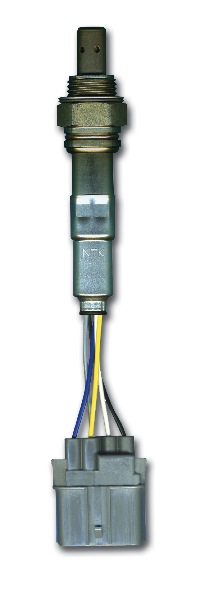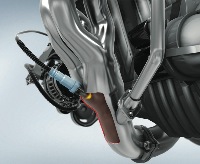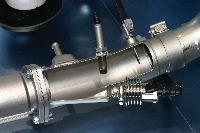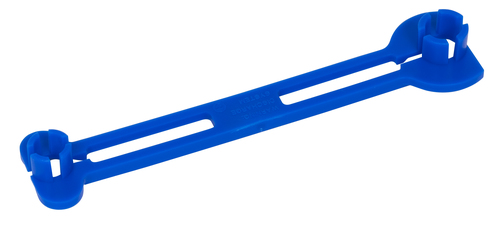
The oxygen (O2) sensor is part of the fuel management system. It monitors unburned oxygen in the exhaust. The powertrain control module (PCM) uses this information to determine if the fuel mixture is rich (too much fuel) or lean (not enough fuel).
To provide the best performance, fuel economy and emissions, the PCM has to constantly readjust the fuel mixture while the engine is running. It does this by looking at the signal from the O2 sensor(s), and then increasing or decreasing the on-time (dwell) of the fuel injectors to control fuel delivery.

INTERNAL HEATERS
Oxygen sensors don’t produce a signal until they’re hot, so the O2 sensors in most late-model vehicles have an internal heater that starts heating up the sensor upon engine startup. Older, first-generation O2 sensors lacked this feature and took much longer to reach operating temperature, which increased cold-start emissions.
Once the sensor is hot, a zirconia-type O2 sensor will generate a voltage signal that can range from a few tenths of a volt up to almost a full volt. When there is little unburned oxygen in the exhaust, the sensor usually generates 0.8 to 0.9 volts. The PCM reads this as a “rich” signal, shortens the duration of the fuel injector pulses to reduce fuel delivery and leans out the fuel mixture.
When there is a lot of unburned oxygen in the exhaust — which may be from a lean fuel mixture, or if the engine has a misfire or compression leak — the O2 sensor will produce a low-voltage signal (0.3 volts or less). The PCM reads this as a “lean” signal, increases the duration of the injector pulses and adds fuel to enrich the fuel mixture.
A slightly different variation on this is the titania-type O2 sensor. Used in some older Nissan and Jeep applications, this type of sensor changes resistance rather than producing a voltage signal.
In recent years, the design of O2 sensors has changed. The ceramic thimble-shaped element in zirconia-type O2 sensors has been replaced by a flat strip ceramic “planar”-style sensor element.
The basic operating principle is still the same (the output voltage changes as O2 levels in the exhaust change), but the new design is smaller, much more robust and reaches operating temperature faster. You can’t see the difference from the outside because the tip of the sensor is covered with a vented metal shroud, but many O2 sensors from 1997 and up use the planar design.
Another change has been the introduction of “wideband” O2 sensors, which are also called “Air/Fuel” or A/F sensors. This type of O2 sensor also uses a flat strip ceramic element inside, but it has extra internal circuitry that allows the sensor to measure the exhaust air/fuel ratio with a much higher degree of precision. It can tell the PCM the exact air/fuel ratio, not just a gross rich or lean indication as other O2 sensors do.

CATALYTIC MONITORING
In 1996, vehicles also began using oxygen sensors to monitor the operation of the catalytic converter. A “downstream” O2 sensor is placed either in or just behind the converter to monitor oxygen levels after the exhaust has reacted with the catalyst.
If the operating efficiency of the converter drops below a certain threshold that might cause an increase in emissions, it sets a diagnostic trouble code (DTC) for the converter and turns on the Check Engine Light.
First-generation O2 sensors typically have a limited service life, and may need to be replaced for preventive maintenance somewhere between 50,000 and 80,000 miles. O2 sensors on 1996 and newer vehicles typically have a much longer service life of 100,000 miles-plus, and do not have to be replaced unless they have been contaminated or damaged.
When O2 sensors get old, they can become sluggish and slow to respond to changes in exhaust oxygen levels. Typical symptoms include a drop in fuel economy and higher exhaust emissions.
A bad O2 sensor should not affect engine starting, cause a misfire (unless the spark plugs become carbon fouled), or cause engine stalling or hesitation problems. A sluggish or fouled O2 sensor will typically read low (lean) and cause the engine to run rich.
O2 sensors can be fouled by silicates if an engine has an internal coolant leak and the cooling system contains a conventional antifreeze with silicate rust inhibitors.
The O2 sensor can also be contaminated by phosphorus and zinc from motor oil if the engine has an oil consumption problem (worn valve guides or piston rings).

If the heater circuit inside the O2 sensor fails, or the sensor stops producing a signal due to an internal failure or a wiring fault (a loose or corroded wiring connector), it will usually set a P0130 to P0147 O2 sensor code.
The codes can be read by plugging a scan tool into the vehicle’s diagnostic connector. But, many times, other engine problems will set codes that may seem to indicate a bad O2 sensor, but in fact do not.
A P0171 or P0174 lean code, for example, means the O2 sensor is reading lean all the time. The real problem may not be a bad O2 sensor, but possibly an engine vacuum leak, low fuel pressure or dirty fuel injectors that are causing the engine to run lean. An engine misfire, leaky exhaust valve or a leak in the exhaust manifold gasket that allows air into the exhaust may also cause this type of code to be set.
If an O2 sensor has failed and needs to be replaced, some aftermarket replacement sensors require splicing the sensor wires to accommodate all the different OEM connector styles. This type of O2 sensor provides greater coverage with fewer part numbers.
Others come with the same style connector as the original and are easier to install, but require many more part numbers for the same coverage.
Ever wonder what causes O2 sensors to fail? As O2 sensors age, they slow down. But this usually isn’t a factor until the sensor has upward of 75,000 or more miles on it. So when an O2 sensor fails prematurely, the cause is often contamination.
Contaminants that can cause an O2 sensor to fail can come from a number of sources. If the engine has an internal coolant leak (due to a crack in the combustion chamber or a leaky head gasket), and the coolant contains silicate corrosion inhibitors (which conventional green coolants do but long-life orange coolants such as Dex-Cool do not), the silicates can pass into the exhaust and contaminate the O2 sensors.
Another source of contamination is the anti-wear ingredients in ordinary motor oil. But, the amount of phosphorus and zinc in motor oil has been reduced in recent years to reduce the risk of O2 sensor and catalytic converter contamination.
Every engine uses a small amount of oil and, over time, the contaminants can add up. As the engine accumulates miles, and the valve guides, rings and cylinders start to wear, oil consumption goes up. Consequently, in a high-mileage engine that is burning oil, phosphorus and zinc contamination of the O2 sensors and catalytic converter can be a problem.
If the O2 sensors are sluggish or have failed, they obviously need to be replaced. But replacing the O2 sensors will only temporarily restore the fuel feedback control system. Unless the oil burning is eliminated, the new O2 sensors will eventually suffer the same fate. The same holds true for a fouled catalytic converter.













